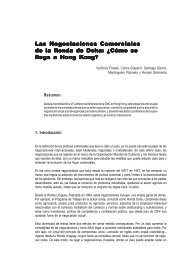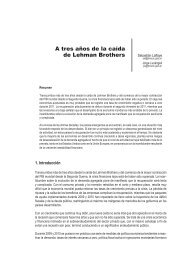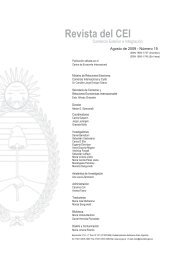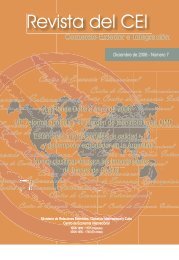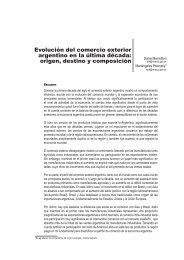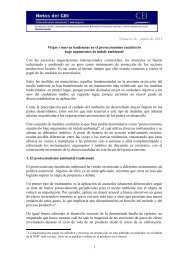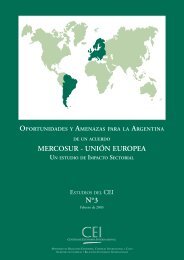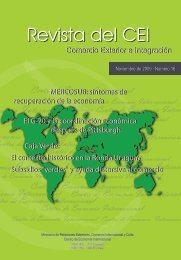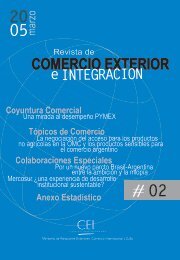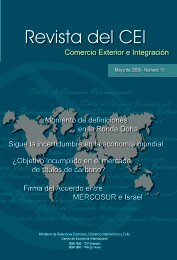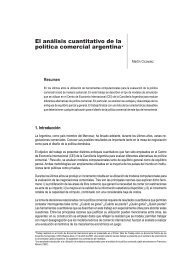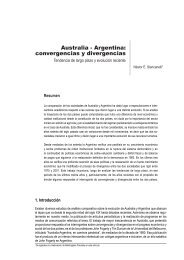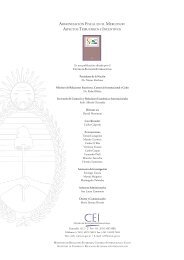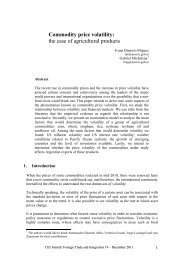Revista del CEI - Centro de EconomÃa Internacional
Revista del CEI - Centro de EconomÃa Internacional
Revista del CEI - Centro de EconomÃa Internacional
You also want an ePaper? Increase the reach of your titles
YUMPU automatically turns print PDFs into web optimized ePapers that Google loves.
It can be stated that Australia has maintained a strong preference for multilateral negotiations since thecreation of the GATT in 1947. During the 90s, it promoted APEC with the aim of encouraging economiccooperation and tra<strong>de</strong> liberalisation in Asia Pacific on a Most Favoured Nation basis. Until the launch ofthe Doha Round at the end of 2001, it had only subscribed the Closer Economic Relations Tra<strong>de</strong>Agreement with New Zealand (CER), a country with which it is linked by their common origin and strongbonds arising from their historical <strong>de</strong>velopment. That stance has been gradually changing towards thecombination of both multilateral negotiations and bilateral free tra<strong>de</strong> agreements.Argentina, in contrast to Australia, has not entered bilateral free tra<strong>de</strong> agreements. Argentina <strong>de</strong>velopsnegotiations of that kind jointly with the rest of the MERCOSUR, mainly with Latin American members ofthe Latin American Integration Association. At a multilateral level, it also takes part of the GeneralisedSystem of Preferences among Developing Countries. This participation, together with MERCOSUR, isbased on the WTO Enabling Clause, which allows granting preferences among <strong>de</strong>veloping countrieswithout requiring these preferences to be exten<strong>de</strong>d to <strong>de</strong>veloped countries. Argentina is currently chairingthe third round of negotiations of the system launched in the city of Sao Paulo in 2004.2. Tra<strong>de</strong>Although Australian exports of goods and services approximately triple those of Argentina, having reachedUS$ 135,933 million in 2005 as compared to US$ 46,357 million for Argentina, both countries havesuffered a significant <strong>de</strong>crease in their share of world exports. Since 1950, when they came to 3.6% and2.0% of the value of global exports of goods, their corresponding market shares dropped to 1.0% and0.4% in 2005, respectively. The fact that their exports are not predominantly targeted at the most dynamicsectors of international <strong>de</strong>mand, namely tra<strong>de</strong> in industrial goods, has meant a loss in terms of theirrelative weight over time. Their lost of share has been gradually taken by European countries, the UnitedStates and Japan, and over the last two <strong>de</strong>ca<strong>de</strong>s, increasingly by China and the countries of SoutheastAsia.If the structure of the world tra<strong>de</strong> in goods is analysed on the basis of value, it can be found that of theUS$ 10.1 trillion exports in 2005, 76% correspon<strong>de</strong>d to industrial products, 15% to minerals and fuels and9% to agricultural products. In the case of Australia, mineral, energy and agricultural products make up73% of the exported value, whereas industrial products explain only 27% of such value. This represents arelation exactly inverse to the structure of world exports. The same happens to Argentina, whose value ofexported goods comprises 32% of primary products (agricultural products, minerals and fuels), 28% ofprocessed agricultural products, and 30% of industrial products (Figure 1).Regarding imports, both countries are focused on industrial products, consumer goods, capital equipmentand inputs for productive activities. The respective proportion, which is over two thirds of imports, shows aconcurrence between those imports and the pattern of world exports such that, for the rest of the world,Australia and Argentina are complementary markets. This phenomenon is in opposition to that of theirexport tra<strong>de</strong>, which has been competing in the least dynamic segment of world <strong>de</strong>mand, although thissituation may have begun un<strong>de</strong>rgoing transformations over the last few years. Tra<strong>de</strong> specialisation can beobserved in Figure 2, with net exports of resources for both countries at almost 90% while net imports ofindustrial products represented over 40% for Argentina and 56% for Australia.As for services, the value of Australian exports was US$ 28,545 million in 2005, representing 1.2% of theUS$ 2.4 trillion world exports. Argentina sold US$ 6,490 million in the same year, falling short of 0.3% ofworld exports. While the ratio of exports of goods between Australia and Argentina is 2.6, that of servicesis 4.4. The importance of exports of educational, financial, transport, tourism and computer servicesexplains the larger difference in the latter case.



